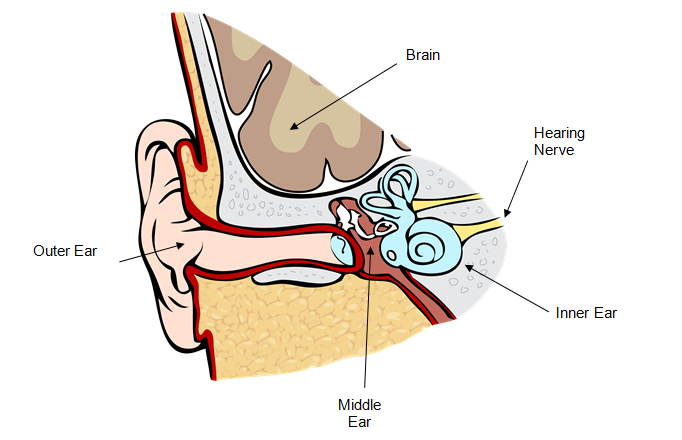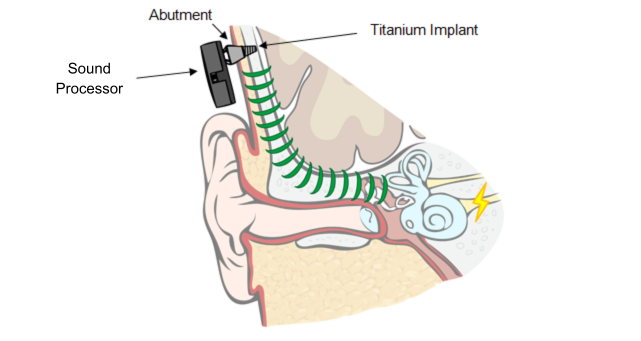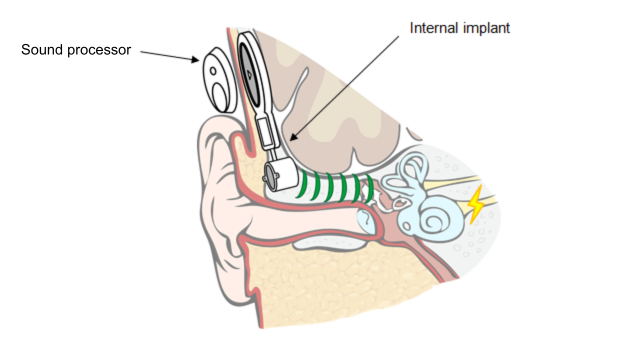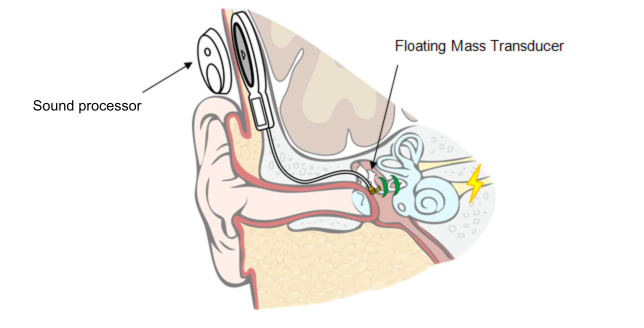Who uses bone condution implants and middle ear implants?
People who have a bilateral (both ears) or unilateral (one ear) conductive or mixed hearing loss and who are not able to hear speech optimally through conventional hearing aids or bone conduction hearing aids, may be referred for bone conduction implant and middle ear implant assessment.
How does the ear work?
The ear is made up of 3 parts, the outer (external) ear, the middle ear and the inner ear.

- The part we can see is the outer ear which also includes the ear canal. It functions to capture sound energy and funnel it to the ear drum. When the sound energy reaches the ear drum it causes the ear drum to move and vibrate.
- There are 3 tiny middle ear bones connected to the ear drum. When the ear drum vibrates it causes the three bones to vibrate as well.
- As these bones vibrate they push against the inner ear (cochlea). The cochlea is a fluid filled organ which contains many sensory cells called hair cells. As the three bones push against the cochlea the fluid inside the cochlea begins to move, which causes the hair cells to move and bend. The hair cells contact the nerve of hearing (auditory nerve) and as they move and bend they stimulate the nerve. The nerve then sends the message to the brain for processing.
A conductive hearing loss
This is caused when there is a problem in the outer or middle ear that stops sounds reaching the inner ear. These problems may include:
- an absence or abnormal shape of the outer ear (microtia)
- a closed ear canal (atresia)
- abnormalities of the middle ear structures.
- long standing difficulties with ear infections
A sensori-neural hearing loss
This is caused when there is a problem in the inner ear, for example, the hair cells in the cochlea or the hearing nerve.
This damage prevents the sound signals from being transmitted to the brain. The loss can be mild, moderate, severe or profound.
A mixed hearing loss
This is caused when there is both a conductive hearing loss and a sensori-neural hearing loss.
Unilateral hearing loss
A unilateral hearing loss is a hearing loss in one ear and normal hearing in the other ear. The loss can be sensori-neural, conductive or mixed.
If one ear has normal hearing and the other side has a profound hearing loss, it is sometimes referred to as single sided deafness.
What is a bone conduction implant?
‘Bone conduction’ is a term used to describe the transmission of sound through bone in the skull. A bone conduction implant is used to bypass any abnormalities of the: outer ear, ear canal and middle ear and directly stimulate the inner ear.
How does a bone conduction implant work?
- Sounds in the environment are picked up by the microphone which sends the signal to the sound processor.
- The sound processor converts the sounds detected into vibrational energy
- The vibrations are then transmitted through the bone in the skull which in turn vibrates the inner ear directly.
- The inner ear is stimulated which in turn stimulates the auditory nerve.
- Nerve impulses are sent to the brain where they are interpreted as sound.
Visit the National Deaf Children's Society website for more information about bone conduction implants.
There are a number of bone conduction implants available
Percutaneous bone conduction implant
This traditional bone conduction implant works with the internal implant and the external speech processor are connected directly to each other through the skin using a connector (abutment). This type of implant penetrates the skin and that is why it is called percutaneous. 
The percutaneous implant has 3 parts:
- Sound processor
- Abutment
- Titanium implant
The percutaneous implant involves:
- An operation to place a small titanium implant in the bone behind the ear.
- A titanium abutment is attached to the implant and protrudes through the skin.
- The sound processor connects directly to the abutment and is worn externally.
- The sound processor can be taken on or off at any time, but sound is only transmitted when the processor is being worn.
Transcutaneous bone conduction implants
The Transcutaneous Bone Conduction implant keeps the skin intact with the internal and external equipment communicating across the skin using a magnet. This type of implant communicates across the skin that is why it is called transcutaneous.
There are currently 3 types of transcutaneous implants:
- Attract system
- Bonebridge system
- Osia system
Attract system

This implant has 4 parts:
- Sound processor
- External magnet
- Internal magnet
- Implant
This transcutaneous implant involves:
- An operation to place a small implant and internal magnet in the bone behind the ear. These internal components are completely under the skin.
- The externally worn sound processor is attached to an external magnet with a soft pad for wearing comfort.
- The internal and external magnets create an invisible connection between the sound processor and the implant.
- The sound processor converts sounds to vibrations and transmits these via the magnets to the implant.
BoneBridge system

The BoneBridge and Osia systems has 2 parts:
- Sound processor with magnet
- Implant with magnet
This transcutaneous implant involves:
- An operation to place the internal implant in the bone behind the ear.
- The internal implant contains an active vibratory mechanism and an internal magnet. These internal components are completely under the skin.
- The externally worn sound processor has a magnet inside it which is attracted to the magnet in the internal equipment.
- The internal and external magnets create an invisible connection between the sound processor and the implant.
- The sound processor captures sound signals and sends them through the skin to the internal implant.
- The implant converts the sound into vibrations and sends them through the bone to the inner ear.
Middle ear implant
A middle ear implant is an implant which stimulates the bones of the middle ear. A middle ear implant is a hearing implant used to bypass the abnormal outer ear and abnormal ear canal to directly stimulate the inner ear.
How does a middle ear implant work?
- Sounds in the environment are picked up by the microphone which sends the signal to the sound processor.
- The sound processor sends the signal across the skin to the internal implant
- The internal implant converts the signal into vibrations which are then transmitted to the middle ear bones which in turn vibrates the inner ear directly.
- The inner ear is stimulated which in turn stimulates the auditory nerve.
- Nerve impulses are sent to the brain where they are interpreted as sound

The middle ear implant has 4 main parts:
- Sound processor
- External magnet
- Internal magnet
- Implant
The middle implant involves:
- an operation to place the internal implant in the middle ear
- the internal implant contains an active vibratory mechanism and an internal magnet. These internal components are completely under the skin
- the externally worn sound processor has a magnet inside it which is attracted to the magnet in the internal equipment
- the internal and external magnets create an invisible connection between the sound processor and the implant
- the sound processor captures sound signals and sends them through the skin to the internal implant.
- the implant converts the sound into vibrations and sends them to the middle ear bones
Visit the National Deaf Children's Society website for more information about middle ear implants.
Which implant is best for me?
Following a thorough assessment, the team will make a recommendation about which bone conduction implant or middle ear implant is best for your child. This will be based on lots of factors.
Can I choose the type of implant?
We offer 3 different brands of implants: Oticon, Cochlear, and Med-el. We'll decide which one will suit your child best and we'll try to offer you a choice.
If I receive a bone conduction implant or middle ear implant, will I be able to hear normally?
A bone conduction implant and middle ear implant does not restore normal hearing.
If the team decide that a bone conduction implant or a middle ear implant is appropriate for your child they will discuss the benefits with you.
Your child will need time to adjust to the new sounds. The degree of success in developing listening skills cannot be predicted. However, your child will be provided with the appropriate training and support to have the best chance of being a successful implant user.
What are the benefits of bone conduction implants and middle ear implants?
The outcomes for each implant recipient will vary and depend on many factors which include: duration of deafness, age at implantation, the presence of any anatomical abnormalities or additional difficulties and the support they receive.
The expected outcomes for you/your child will be discussed with you during the assessment.
What are the risks?
You or your child will have a general anaesthetic and therefore be asleep for the cochlear implant surgery.
For more information please click on one of the following links
Every operation carries risks and possible side effects. The chances of these occurring are very small and many only last a short time following surgery. These may include:
- infection
- bleeding
- dizziness
- nausea
- vomiting
- tinnitus (ringing in the ears)
- weakness in facial muscles
- taste disturbances
- leak of cerebrospinal fluid (the fluid surrounding the brain)
Many of these are able to be monitored during surgery or treated immediately after.
Are there other alternatives?
If your child does not want to have surgical intervention they can continue to wear hearing aids or bone conduction hearing aids.
Images credit: Mr Scott Maskell, MBBS BMedSci(Hons) DO-HNS MEd FRCS(ORL-HNS)